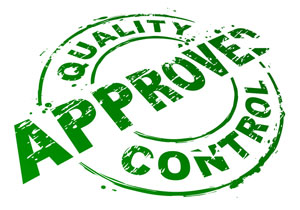Andy Trainer
19 Jul 2012
Managing Quality in PRINCE2

The word “theme” is used in PRINCE2® to refer to the various crucial aspects of a project, why they should be a priority, and how they should be controlled. They are known as themes because they are referred back to throughout the whole PRINCE2 process.
The PRINCE2 themes are Business Case, Organisation, Plans, Progress, Risk, Quality and Change. A few weeks ago, I talked about the Plans theme of PRINCE2, and now it’s time to outline the Quality theme. Of course, we go through all the PRINCE2 themes and processes in our PRINCE2 training courses, to equip you to pass the exams and to give you real-world knowledge that you can apply as soon as you return to work.
Quality of the output is a priority within PRINCE2 projects - and of course for all business owners, CEOs and project managers. Once the customer’s expectations of quality have been identified, standards will be documented and processes put in place to check throughout the project lifecycle that these quality standards are going to be met. Part of the quality theme is ensuring that these processes are being used correctly.
The Quality Theme in PRINCE2
In a nutshell, the purpose of the quality theme is to define and implement the means by which the project will create products that are fit for purpose. This has two approaches – making sure the customer’s expectations are met and ensuring the expected benefits of these expectations are realised and achieved. This is often overlooked when projects are run without structure – the benefits of the product to the customer are ultimately what they are looking for, and supplying a product that doesn't lead to these expected benefits will mean disappointment.
The Quality theme covers both the quality of the final product and the quality of the project management. Many businesses will have quality standards and assurance practices in place before implementing PRINCE2, and PRINCE2 is flexible enough to fit within these.
Product Quality
The Quality theme of PRINCE2 ensures an explicit common understanding of what the project will create (the scope) and the criteria against which the project’s final product(s) will be assessed.
The most important thing is that the customer’s quality expectations are documented along with how they will be assessed in a quantifiable way. If a customer is being vague about their quality requirements, the project manager must take responsibility for clarifying these and documenting the results. Customer quality expectations should also be prioritised in case something has to be compromised whilst the project is in progress.
Once the required quality has been identified and documented, the costs and timescales for the project can be estimated. If these are too high then the customer may need to reconsider their quality expectations.
All quality criteria must include tolerances within which the quality can vary, and by how much.
The Quality Trail
There are 11 steps in the PRINCE2 Quality Trail:
- Ascertaining customer quality expectations
- Defining the acceptance criteria
- Writing a Quality Management Strategy
- Adding quality details to the Stage Plan
- Identifying planned quality check dates
- Defining a product’s quality criteria
- Explaining the quality requirements for each piece of work
- Reporting on the quality of work produced
- Checking that quality work is being done correctly
- Controlling change
- Keeping track of changes to products
Management Quality
The Quality theme also covers the implementation of continuous improvement during the project, e.g. looking for ways to make the project management practices more effective or efficient. This is expressed along the way and when reviewing the project once the product has been delivered. This focus on continuous improvement is important to the PRINCE2 method, so the quality of the practices that achieved the final product is seen as just as important as the quality of the product itself.
An example of managing process quality could be how quickly the project manager became aware of and reacted to issues during the execution of the project. If these were not identified quickly, the project board should assess why this was and how the project could be run differently next time.
For more on the PRINCE2 process, have a look at our process model diagram.

Quality Documentation
The quality requirements for a project and its products are documented in many forms. In many cases, a Quality File will be created, which contains the Quality Register, the Product Descriptions, and other documents related to quality.
Product descriptions created in the Starting Up A Project process are included in the Project Brief and will include quality requirements for the final product as well as other products required along the way.
The Quality Management Strategy is created during Project Initiation and identifies the quality standards that will be used across the project and the main quality responsibilities. This will reference and feed back to the relevant existing Quality Assurance processes of the customer, supplier and/or organisation carrying out the project. The Quality Management strategy will also contain details of personnel responsibilities for controlling quality.
The Quality Register will summarise tests that have been planned, who will perform them and the results of these as they are carried out. As each stage plan is created, the Project Manager will enter details in the Quality Register.
Each stage plan will identify when the products of that stage will be checked against acceptance criteria, how and by whom.
Quality Reviews will be carried out by the customer or the end user, to check the product meets its product description and quality criteria.
 The PRINCE2 themes are Business Case, Organisation, Plans, Progress, Risk, Quality and Change. A few weeks ago, I talked about the
The PRINCE2 themes are Business Case, Organisation, Plans, Progress, Risk, Quality and Change. A few weeks ago, I talked about the